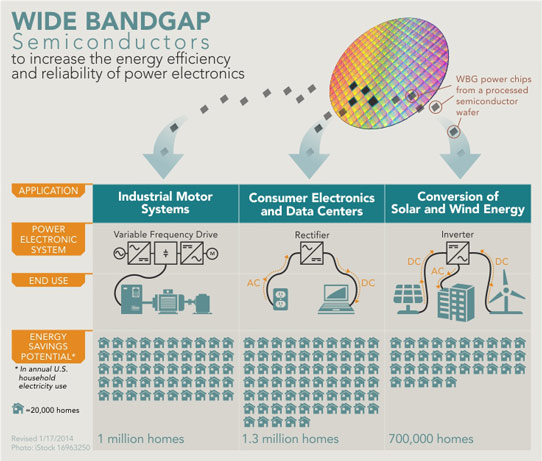- News
15 January 2014
US DOE selects NCSU to lead $140m Next Generation Power Electronics Innovation Institute
The Obama administration has announced the selection of a consortium (headquartered in Raleigh, NC) of more than 25 companies, universities and state and federal organizations to lead a US public-private manufacturing innovation institute for next-generation power electronics. Supported by a $70m investment over five years by the Advanced Manufacturing Office within the Department of Energy’s Office of Energy Efficiency and Renewable Energy (EERE) (the largest single grant in NC State history) as well as a matching $70m in non-federal cost-share from the consortium partners, the Next Generation Power Electronics Innovation Institute aims to invent and manufacture wide-bandgap (WBG) semiconductor-based power electronics that, within the next five years, are cost-competitive and 10 times more powerful than current silicon-based technology on the market.
Led by North Carolina State University (NCSU) and headquarters on its Centennial Campus, the winning consortium includes the State of North Carolina plus 18 companies (ABB, APEI, Avogy, Cree, Delphi, Delta Products, DfR Solutions, Gridbridge, Hesse Mechantronics, II-VI, IQE, John Deere, Monolith Semiconductor, RF Micro Devices, Toshiba International, Transphorm, USCi, Vacon) and 7 universities and labs (NCSU, The University of North Carolina, Arizona State University, Florida State University, University of California at Santa Barbara, Virginia Polytechnic Institute, National Renewable Energy Laboratory).
The DoE says that, as we reach the limits of silicon-based electronics for some critical applications in power conversion, wide-bandgap semiconductors are expected to jumpstart the next generation of smaller, faster, cheaper and more efficient power electronics for personal devices, electric vehicles, renewable power interconnection, industrial-scale variable speed drive motors, and a smarter, more flexible grid.
Revolutionizing power electronics
In the last century, silicon-based power electronics – which control or convert electrical energy into usable power – transformed the computing, communication and energy industries and gave consumers and businesses more powerful laptops, cell phones and motors. Now, WBG semiconductors offer a new opportunity to achieve unprecedented performance while using less electricity, says the DoE.
WBG semiconductors such as silicon carbide (SiC) and gallium nitride (GaN) can operate at higher temperatures and have greater durability and reliability at higher voltages and frequencies. With this technology, the size of a typical laptop power adapter can be shrunk to a fifth of the size of existing adapters, while providing better performance and cutting energy use about 20%. In a typical laptop, a quarter of the power flowing from the wall outlet is lost as waste heat; WBG semiconductors could cut these power conversion losses by up to 90%.

WBG semiconductors could also transform the plug-in electric vehicle industry, making it easier and cheaper to own and drive an electric vehicle, reckons the DoE. For example, they could reduce the size of a vehicle cooling system by about 60% and cut the size of a fast DC charging station to the size of a kitchen microwave.
Building a smarter, more reliable and resilient power grid
As the cost of clean energy technologies continues to come down, seamless and efficient grid integration will help to make these resources and products even more affordable, while giving consumers more control over how they use energy in their homes and businesses, says the DoE. WBG semiconductors should help to overcome a range of generation, transmission, distribution and end-use challenges to support a cleaner, affordable and more secure energy mix.
Power electronics – such as inverters, transformers and transistors – help to control and convert electricity and are playing a growing role in electricity generation, distribution and transmission. According to a study by the Oak Ridge National Laboratory (ORNL), about 30% of all existing power generation utilizes power electronics between the point of generation and its end use. By 2030, this is expected to jump to 80% of generated electricity – supporting greater renewable energy integration and increased grid reliability. WBG semiconductor-based power electronics should be able to better withstand the power loads and switching frequencies required by next-generation utility technologies.
Power electronics that use WBG semiconductors will also be smaller, more efficient and cost less, notes the DoE. A WBG inverter (which switches electricity from direct current to alternating current) could be four times more powerful, half the cost and a quarter the size and weight of a traditional inverter. At a larger-scale, WBG semiconductors could help to reduce the size of an 8000lb substation to 100lb and the size of a suitcase, ultimately helping to lower the cost of electricity and build a stronger, more reliable grid.
Supporting economic growth
The Next Generation Power Electronics Institute supports President Obama’s vision for a full National Network of Manufacturing Innovation of up to 45 institutes that aim to boost employment and manufacturing and ensure that US workers have the training they need. It is the first of three manufacturing innovation institutes established through a Federal commitment of $200m across five Federal agencies: Defense, Energy, Commerce, NASA, and the National Science Foundation. The other two manufacturing innovation institutes, led by the Department of Defense, will focus on ‘Digital Manufacturing and Design Innovation’ and ‘Lightweight and Modern Metals Manufacturing’.
www1.eere.energy.gov/manufacturing/innovation/facilities/wbg.html


